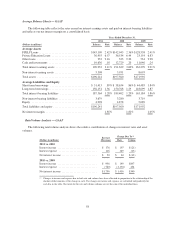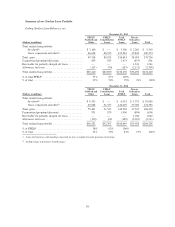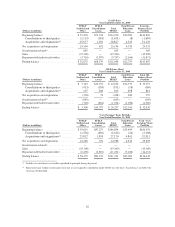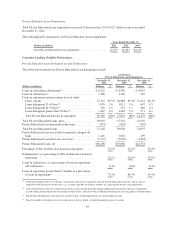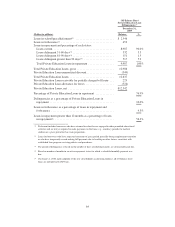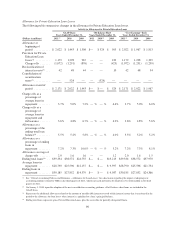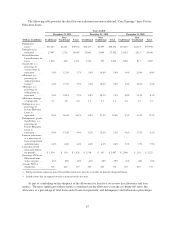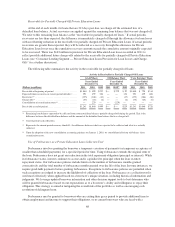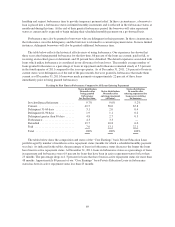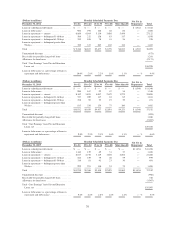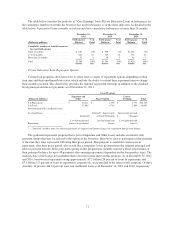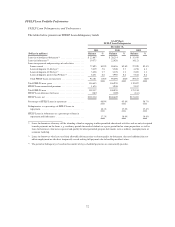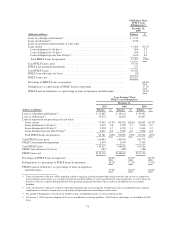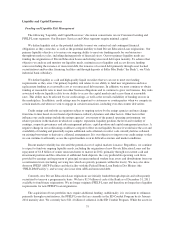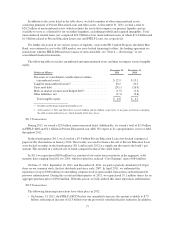Sallie Mae 2011 Annual Report Download - page 70
Download and view the complete annual report
Please find page 70 of the 2011 Sallie Mae annual report below. You can navigate through the pages in the report by either clicking on the pages listed below, or by using the keyword search tool below to find specific information within the annual report.
Receivable for Partially Charged-Off Private Education Loans
At the end of each month, for loans that are 212 days past due, we charge off the estimated loss of a
defaulted loan balance. Actual recoveries are applied against the remaining loan balance that was not charged off.
We refer to this remaining loan balance as the “receivable for partially charged-off loans.” If actual periodic
recoveries are less than expected, the difference is immediately charged off through the allowance for loan losses
with an offsetting reduction in the receivable for partially charged-off Private Education Loans. If actual periodic
recoveries are greater than expected, they will be reflected as a recovery through the allowance for Private
Education Loan losses once the cumulative recovery amount exceeds the cumulative amount originally expected
to be recovered. There was $143 million in provision for Private Education Loan losses recorded in 2011 to
reflect possible additional future charge-offs related to the receivable for partially charged-off Private Education
Loans (see “Consumer Lending Segment — Private Education Loans Provision for Loan Losses and Charge-
Offs” for a further discussion).
The following table summarizes the activity in the receivable for partially charged-off loans.
Activity in Receivable for Partially Charged-Off Loans
GAAP-Basis Off-Balance Sheet “Core Earnings” Basis
Years Ended
December 31,
Years Ended
December 31,
Years Ended
December 31,
(Dollars in millions) 2011 2010 2009 2011 2010(4) 2009 2011 2010 2009
Receivable at beginning of period .................... $1,040 $ 499 $222 $— $ 229 $ 92 $1,040 $ 728 $314
Expected future recoveries of current period defaults(1) .... 391 459 324 — — 156 391 459 480
Recoveries(2) ..................................... (155) (104) (43) — — (17) (155) (104) (60)
Charge-offs(3) .................................... (35) (43) (4) — — (2) (35) (43) (6)
Consolidation of securitization trusts(4) ................. — 229 — — (229) — — — —
Receivable at end of period .......................... $1,241 $1,040 $499 $— $ — $229 $1,241 $1,040 $728
(1) Remaining loan balance expected to be collected from contractual loan balances partially charged-off during the period. This is the
difference between the defaulted loan balance and the amount of the defaulted loan balance that was charged off.
(2) Current period cash collections.
(3) Represents the current period recovery shortfall – the difference between what was expected to be collected and what was actually
collected.
(4) Upon the adoption of the new consolidation accounting guidance on January 1, 2010, we consolidated all of our off-balance sheet
securitization trusts.
Use of Forbearance as a Private Education Loan Collection Tool
Forbearance involves granting the borrower a temporary cessation of payments (or temporary acceptance of
smaller than scheduled payments) for a specified period of time. Using forbearance extends the original term of
the loan. Forbearance does not grant any reduction in the total repayment obligation (principal or interest). While
in forbearance status, interest continues to accrue and is capitalized to principal when the loan re-enters
repayment status. Our forbearance policies include limits on the number of forbearance months granted
consecutively and the total number of forbearance months granted over the life of the loan. In some instances, we
require good-faith payments before granting forbearance. Exceptions to forbearance policies are permitted when
such exceptions are judged to increase the likelihood of collection of the loan. Forbearance as a collection tool is
used most effectively when applied based on a borrower’s unique situation, including historical information and
judgments. We leverage updated borrower information and other decision support tools to best determine who
will be granted forbearance based on our expectations as to a borrower’s ability and willingness to repay their
obligation. This strategy is aimed at mitigating the overall risk of the portfolio as well as encouraging cash
resolution of delinquent loans.
Forbearance may be granted to borrowers who are exiting their grace period to provide additional time to
obtain employment and income to support their obligations, or to current borrowers who are faced with a
68


